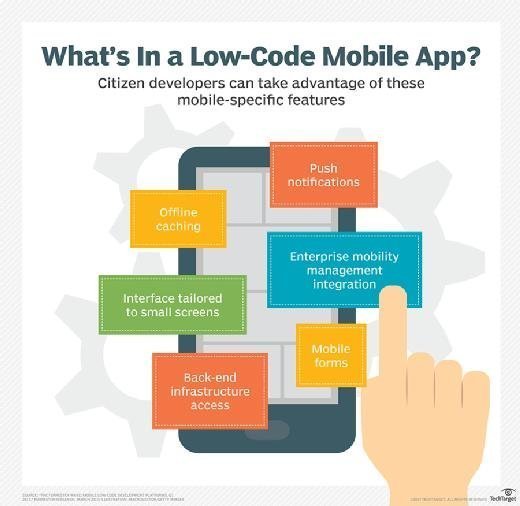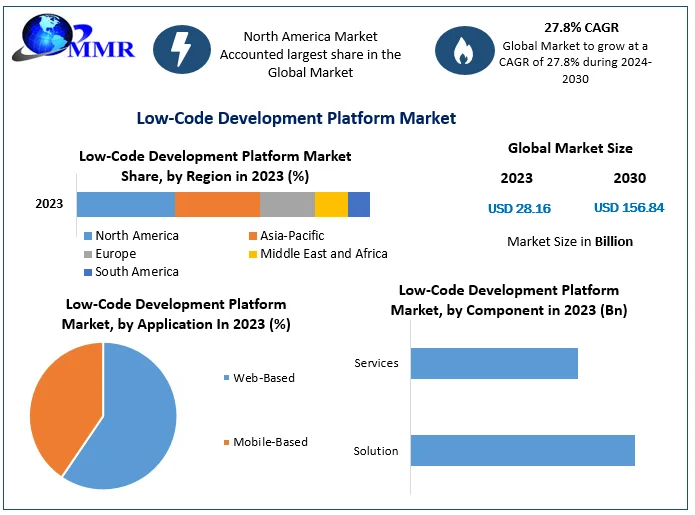Handy News To Picking Low-Code Platform Examples
Handy News To Picking Low-Code Platform Examples
Blog Article
Benefits Of Low-Code Application Development In The Sense Of Accessibility To Non-Developers
Due to a number of factors the development of low-code applications is more accessible to non-developers. These are sometimes referred to as "citizens developers."
Drag-and-Drop Builders: Low-code systems feature drag-and-drop interfaces that enable non-developers to design applications without writing code. This makes the development process more accessible to those without technical background.
WYSIWYG: WYSIWYG editors are "What you see is what you get" editors that allow users to create workflows and interfaces similar as the final product. This makes it simpler to understand and use.
Simplified Design of Workflow Logic and Workflow:
Visual Workflow Design: Users can quickly design business processes and application logic using flowcharts, models and diagrams. They are much easier to work with than traditional coding.
Pre-built Logic components Low-code platforms contain logic components that have been already built (e.g. conditional loops and statements) that can be easily customized which eliminates the need for complicated coding.
Reusable Components and Templates
Library of Pre-built Templates: Numerous low-code platforms have a library of templates for common application types, enabling non-developers to start from a solid base and modify as they need to.
Reusable Widgets and Modules: Utilizing the reuse of modules and widgets users can simplify the design process while reducing their requirements for technical expertise.
Guided Development & Tutorials
Step-by-Step instructions Platforms typically offer tutorials on screen, guiding development routes and other tools to help non-developers create applications.
Interactive Tutorials: Interactive, hands-on tutorials help users learn by doing, enhancing their knowledge and confidence using the platform.
Integration with Existing Tools
Seamless integration Low-code platforms are created to be able to seamlessly integrate with existing tools and systems for business (e.g. ERP, CRM) making it possible for non-developers to develop applications that fit into their workflows.
APIs Connectors, APIs: These tools simplify integration by allowing non-developers (or even end users) to connect their apps with external services.
Collaboration Features:
Team Collaboration: Features like real-time collaboration and shared workspaces let non-developers to work alongside professionals, business analysts and other stakeholder groups effectively.
Role-based Access Control: You can give non-developers certain roles with the appropriate access level, so they are able to participate in the development process without hindering security or the functionality.
Automated Testing and Debugging:
Low-code platforms usually come with testing and debugging software that automates these processes. This makes it easier for non-developers to ensure that their applications function correctly.
Error highlighting: The system highlights issues and suggests fixes to guide non-developers.
The general rule is that low-code app development is able to make development more accessible to everyone. This is a significant benefit for developers who are not. Low-code platforms enable business users to participate actively in the development and maintenance of applications through the use of intuitive visual tools as well as a guiding user experience. This helps bridge the gap between business and technical needs. View the best Low-code Platform for application development url for website info including software for app development, app platforms, low code development platforms, cloud software applications, mobile app development platforms, build with docker, lowcode no code, rad application development, stored sql procedures, application modernization software and more.
Benefits Of Low-Code Applications In Safety And Governance
Low-code development has several benefits regarding security and governance. These are crucial to ensure that applications are secure, compliant and properly managed throughout their lifecycle. These are the main advantages: Centralized Governance
Unified management console: Low-code platforms typically have a central administration console where administrators can manage all applications and ensure consistent governance within the organization.
Role-Based Access Control RBAC : These platforms typically have robust roles-based access controls, which enable administrators to create and enforce policies. This permits only authorized users to alter or access specific areas of the program.
Compliance and Regulatory Adherence
Many low-code platforms include integrated compliance features. They are developed in accordance with the industry standards, regulations and laws (e.g. HIPAA, GDPR). They provide tools and templates to ensure that the applications are compliant with these regulations.
Audit Trails & Logging: Complete audit trails and logs can be integrated to enable organizations to track change, monitor access and ensure conformity.
Improved Security Measures:
Data encryption. Low code platforms typically provide encrypted data built-in during transport and during rest. This safeguards sensitive data.
Security Certificates: A lot of low-code providers have a security certificate (e.g. ISO 27001 and SOC 2) which demonstrate that they are adhering to strict security standards. They also provide an extra degree of security to clients.
Automated Security Updates
Regular Patching and Updating Lowcode platforms generally handle regular updates to security. These patches safeguard applications against the latest threat without requiring the involvement of developers.
Security Monitoring: Continuous security monitoring tools can be used to send real-time notifications as well as information about potential security concerns.
Data Governance:
Data Access Policy: These platforms let companies define and enforce rules for data access, making certain that only authorized users are able to access data, and it is used properly.
Data Masking and Anonymization Built-in tools for data masking and anonymization protect sensitive information, especially when working in testing and development environments.
Consistent Lifecycle Management of Applications:
Development and deployment pipelines: Low-code platforms allow for integrated development, including security checks. This provides security throughout the entire lifecycle of an application.
Version Control: A unified version control system can help manage changes, allowing any modifications that are made to an application to be monitored. If needed, these can be reverted and the integrity of the application maintained.
User Authentication & Authorization:
Single Sign-On (SSO). Support for advanced authentication and single sign-on simplifies and enhances security.
Multi-Factor Authentication - Many platforms can support multi-factor Authentication, which adds an extra layer to security when accessing applications.
Policy Enforcement and Compliance:
Policy Templates: Low code platforms typically have templates for governance and security that enable organizations to quickly apply policies.
Tools for Compliance Monitoring: These tools monitor and continuously report on compliance status. They make it easier to spot problems and address the issues in a proactive way.
Integration with Existing Security Infrastructure
seamless integration: Low-code platforms have been designed to work with current security tools and infrastructure, such as identity management systems and SIEM (Security Information and Event Management) solutions, and firewalls.
API Security: API security features that protect data and maintain application integrity are built into the API.
Training and best practices
Good practices: Several platforms provide guidelines for the development of secure applications and provide best practices. This helps non-developers to follow security standards.
Security Training: Certain low-code vendors offer security training as well as resources to educate users on how to build and maintain secure applications.
Overall the security and governance advantages of developing applications using low-code make sure that applications are created and operated in a secure as well as compliant method. These platforms have the tools, frameworks and regulatory compliance that are required to safeguard sensitive customer information as well as enforce policies and keep regulatory compliance in check and ease the administration and supervision of the development process. View the top rated Enterprise application development with Low-code Platform examples for site examples including rapid action development, jdbc server, software for app development, paas service, low code development platforms, lowcode no code, jdbc server, rapid action development, develop cross platform mobile app, app modernisation and more.
Advantages Of Low-Code Application Development In Terms Of Collaboration And Workflow
Low-code development can offer many benefits for collaboration and workflow. This makes it a great solution for businesses seeking to increase productivity and speed up the development process. Here are some key advantages.
Unified Development Environment : Low-code platforms provide a single, unified environment where all team members are able to work effectively including designers, business analysts and stakeholders. This helps eliminate silos and encourages more effective communication.
Visual Development Tools: Low-code platforms are easy to use and feature an interface that allows drag-and-drop. This lets non-technical people on the team to take part in the process of development and ensures that the business requirements are captured in a precise manner.
Improved Communication:
Real-Time Collaboration: A lot of low-code platforms offer real-time collaboration capabilities like the simultaneous editing of comments and instant feedback. These features facilitate continuous communication and reduce the time spent on back-and-forth conversations.
Workspaces shared by teams are able to collaborate on shared workspaces in which they modify and discuss project components. This ensures that everyone is working towards the same goals and is on the same page.
Streamlined Workflow Management:
Integrated Project Management Tools: A lot of low-code software platforms include integrated tools for project management that can help teams track and manage their development projects. This includes tasks assignment as well as monitoring progress and deadlines management.
Workflow automation: The automation of repetitive tasks, workflows, as well as other processes decreases the amount of manual work required and eliminates mistakes. This lets teams focus on higher-value activities and increases efficiency.
Faster Iteration Cycles:
Rapid prototyping. A low-code platform allows rapid prototyping. This enables feedback to be incorporated quickly into the application as well as rapid enhancements.
Support for Agile Methodologies: Using agile methods gives teams the ability to be agile and work in sprints, and to continuously provide small amounts of functionalities, making it easier to adapt to the changing demands.
Accessibility for non-Developers
Citizen-driven development platforms permit business users to modify and create applications without extensive programming knowledge. This helps to reduce the burden on IT and development departments and lets them respond faster to business demands.
Training and Onboarding: Intuitive interfaces and a wealth of training materials make it simpler for new members to learn the ropes and improve the overall cohesion within the team.
Centralized Knowledge Sharing and Documentation:
Documentation integrated: Low-code platform features often allow you to create and manage documents on the platform. The entire project's information will be centralized and easily accessible.
Knowledge Repositories. Teams can set up repository for knowledge that includes templates and reusable parts. This will facilitate sharing of knowledge and will reduce the amount of duplicate information.
Standardization and consistency:
Standardized components: Standardized, pre-built component ensures uniformity in the applications. Team members are able to understand and work with greater ease on different parts.
Governance and Compliance - The built-in governance frameworks make sure that the creation process of all applications conforms to the organizational standards as regulatory guidelines. This reduces non-compliance risk and assures that applications comply with high-quality standards.
Feedback and Improvement Loops
Integrated Feedback Mechanisms Low-code platforms usually have integrated feedback mechanisms that allow users to easily give feedback to applications. This can then be incorporated into the process of development.
Continuous Improvement: The capacity to quickly test and then deploy modifications as a result of feedback ensures the continuous improvement of the applications. They are aligned closely with users' needs and business goals.
Visualization and reporting
Real-time analytics built-in reporting and analytical features give real-time insight into project progress, performances, and user interactions. They allow data-driven, informed decision-making.
Visual Workflow Mapping Visual tools for mapping workflows and processes help teams to understand and improve their workflows by identifying bottlenecks and areas for improvement.
Low-code development offers many benefits in regards to workflow and collaboration. It can bring diverse teams together, improve processes, improve communication, and enhance collaboration. This fosters a team-oriented environment with an agile and efficient development process that results in better-quality applications and better alignment between business goals.